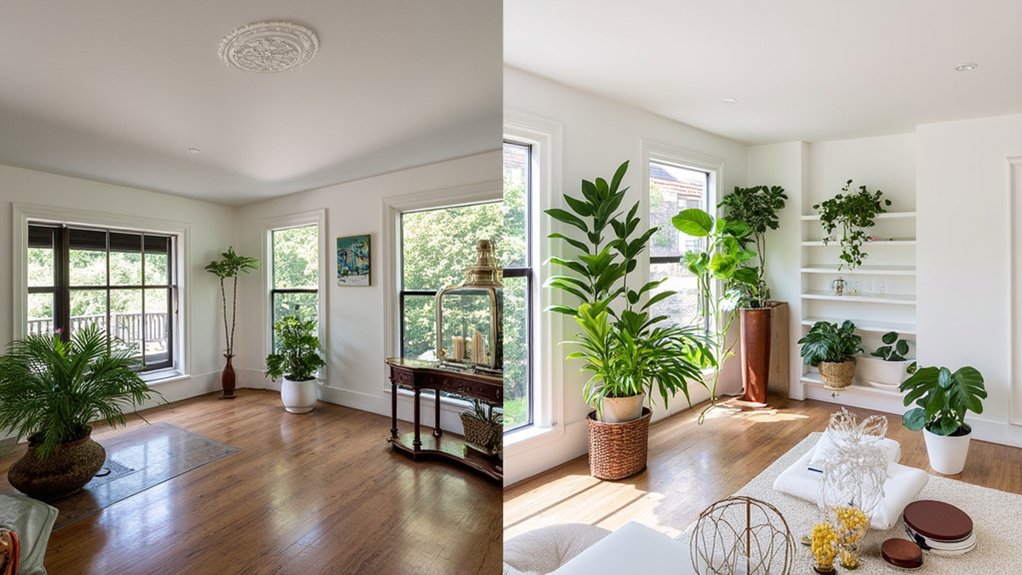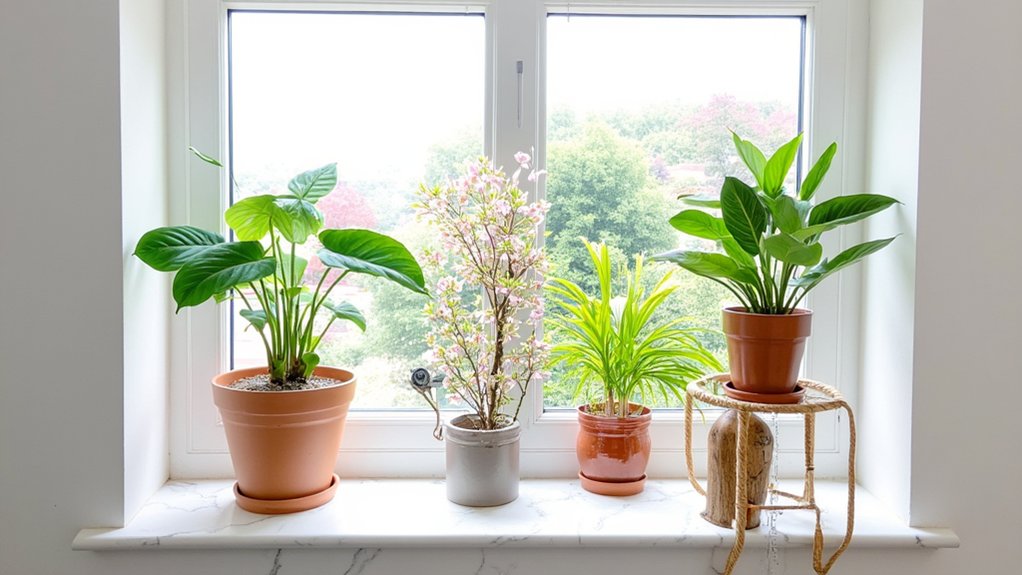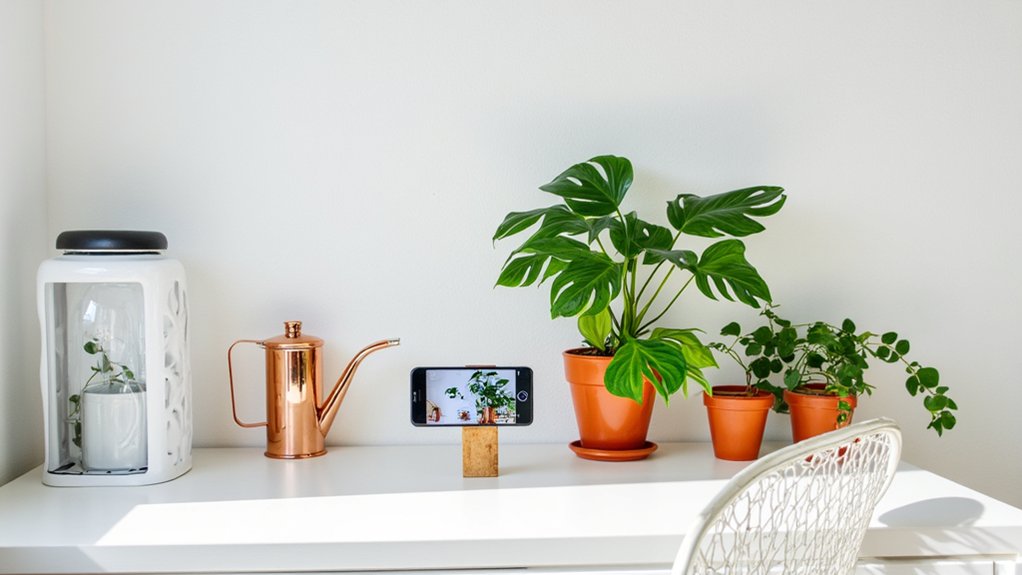Just as Darwin discovered evolution in nature, you’ll find that houseplants have undergone their own remarkable transformation since the Victorian era. You’re living in a time when indoor gardening has shifted from exclusive conservatories to everyone’s living spaces, with 66% of American households now nurturing at least one plant. From vintage Wardian cases to today’s smart self-watering pots, the journey of indoor gardening reveals fascinating changes in how we’ve brought nature indoors over the past 150 years.
Contents
- 1 From Victorian Parlors to Modern Living Rooms
- 2 The Social Media Plant Revolution
- 3 The Rise of Plant Influencers and Digital Communities
- 4 Rare Plant Collecting: The New Urban Treasure Hunt
- 5 Wellness Benefits of Indoor Gardening
- 6 Millennial Plant Parents: Redefining Home Decor
- 7 The Business of Botanical Retail
- 8 Urban Jungle Design Trends and Aesthetics
- 9 Plant Care Technology and Smart Growing Solutions
- 10 Sustainability and Environmental Impact of Indoor Plants
From Victorian Parlors to Modern Living Rooms

While plants have adorned indoor spaces for centuries, the Victorian era marked the true beginning of decorative indoor gardening. You’ll find that wealthy Victorians displayed exotic ferns and palms in specially designed glass cases called Wardian cases, which protected delicate specimens from coal smoke and dry indoor air.
Today’s houseplant trends echo these Victorian roots, but you’re not limited to formal displays. You’ll see plants thriving in modern macramé hangers, geometric terrariums, and vertical gardens. From Boston ferns to fiddle leaf figs, you’re carrying on a tradition that’s evolved from stuffy parlors to your contemporary living space.

Three major social platforms have revolutionized how we discover, share, and learn about indoor plants since 2015. Instagram’s #plantsofinstagram has garnered over 12 million posts, while Pinterest’s plant care guides reach millions of users monthly. You’ll find TikTok’s #plantTok featuring quick tutorials on propagation and maintenance.
These platforms have transformed casual plant owners into “plant parents,” with 67% of millennials identifying in this way by 2022. You can now instantly access care tips, join virtual plant swaps, and participate in trending challenges like “plant shelfies” or “propagation stations,” making indoor gardening more accessible and community-driven than ever before.
The Rise of Plant Influencers and Digital Communities

As social media’s influence on indoor gardening has exploded, plant influencers have cultivated massive followings by sharing their botanical expertise. You’ll find these digital gardeners posting daily care tips, propagation tutorials, and stunning photos of their indoor jungles across Instagram, TikTok, and YouTube.
These plant-focused content creators don’t just share pretty pictures. They’re building engaged communities where you can troubleshoot pest issues, trade cuttings, and connect with fellow enthusiasts. Many influencers host live Q&A sessions, offering real-time solutions for your growing challenges.
Digital plant communities have transformed solitary gardening into a collaborative experience, with hashtags like #PlantParenthood connecting millions of growers worldwide.
Rare Plant Collecting: The New Urban Treasure Hunt
Since social media has made rare plants more visible than ever, collectors are increasingly willing to pay premium prices for unusual specimens like variegated monsteras and pink princess philodendrons. You’ll find these coveted plants commanding prices from $100 to well over $5,000, depending on size and rarity.
To start your rare plant collection, you’ll need to research reputable sellers, join plant trading groups, and learn proper care techniques. Many collectors begin with easier-to-find varieties like string of hearts or watermelon peperomia before moving to rarer specimens.
Watch for scams, as some sellers may try to pass off regular plants as rare variants through manipulated photos or false claims.
Wellness Benefits of Indoor Gardening
Whether you’re a seasoned plant parent or just starting out, indoor gardening offers substantial mental and physical health benefits. Research shows that tending to houseplants can reduce stress levels by up to 40% while increasing productivity by 15%.
You’ll breathe easier too, as plants like snake plants and peace lilies naturally filter indoor air pollutants. Just three medium-sized plants per 100 square feet can remove up to 87% of air toxins within 24 hours.
The simple act of caring for plants also improves focus and memory retention. When you water, prune, or repot your green friends, you’re engaging in mindfulness activities that stimulate cognitive function and boost mood-enhancing serotonin levels.
Millennial Plant Parents: Redefining Home Decor
Three defining traits set millennial plant parents apart in today’s design landscape: their preference for statement plants, minimalist containers, and integration of greenery into every room.
You’ll notice their affinity for dramatic specimens like Monstera deliciosa and fiddle leaf figs, often positioned as living focal points in 8-foot-tall corners. Their pots typically feature clean lines in neutral tones, with matte finishes and geometric shapes taking center stage.
Unlike previous generations who confined plants to windowsills, millennials incorporate greenery throughout their living spaces. You’ll find hanging plants in bathrooms, herb gardens in kitchens, and cascading pothos vines adorning bedroom shelves, creating a cohesive, nature-inspired aesthetic.
The Business of Botanical Retail
As indoor plant sales have skyrocketed past $1.7 billion annually, botanical retailers are adapting their business models to meet modern consumer demands. You’ll now find plant shops offering workshops, subscription boxes, and specialized care services along with their greenery.
The retail landscape has shifted from traditional garden centers to boutique experiences, where you can sip coffee while selecting your next plant baby. Many shops now employ certified plant specialists who’ll teach you proper care techniques, and they’re expanding their online presence with virtual consultations.
Plant retailers have also embraced social media marketing, with 73% using Instagram to showcase their inventory and build community engagement.
Urban Jungle Design Trends and Aesthetics
Modern homes have become living canvases for creative plant displays, with the urban jungle aesthetic leading interior design trends. You’ll find hanging plants cascading from macramé holders, while shelving units showcase collections of varied leaf textures and shapes.
To achieve this look, you’ll want to layer plants at different heights, incorporating at least three vertical levels. Start with floor plants like Monstera deliciosa, add mid-level plants on stands or tables, and finish with trailing plants like pothos or string of pearls overhead.
Mix conventional pots with unique containers, spacing plants 12-18 inches apart to create visual breathing room.
Plant Care Technology and Smart Growing Solutions
Smart technology has revolutionized the way you’ll care for indoor plants, with automated systems now handling everything from watering schedules to light monitoring. You’ll find Wi-Fi-enabled sensors that track soil moisture, temperature, and nutrient levels in real-time, sending alerts straight to your smartphone.
Self-watering systems have evolved beyond basic reservoirs, now incorporating precision drip technology that measures exactly how much water each plant needs. LED grow lights with programmable spectrums can simulate natural daylight patterns, while smart plant pots adjust watering based on individual species requirements and seasonal changes, ensuring your plants thrive with minimal intervention.
Sustainability and Environmental Impact of Indoor Plants
While indoor plants naturally improve air quality, their overall environmental impact depends heavily on your growing practices. You’ll find that using LED grow lights instead of traditional bulbs can reduce your energy consumption by up to 75%, while collecting rainwater for irrigation helps conserve water resources.
Consider choosing sustainable potting materials, like coconut coir or recycled plastic containers, rather than peat-based mixes that deplete natural bog ecosystems. You can also minimize your carbon footprint by propagating your own plants from cuttings and composting plant waste. When purchasing new plants, opt for locally grown varieties to reduce transportation emissions.
